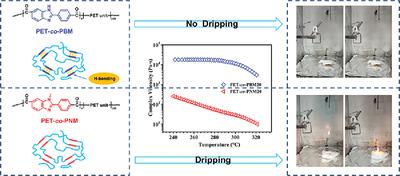当前位置:
X-MOL 学术
›
Macromol. Mater. Eng.
›
论文详情
Our official English website, www.x-mol.net, welcomes your
feedback! (Note: you will need to create a separate account there.)
How Hydrogen Bond Interactions Affect the Flame Retardancy and Anti‐Dripping Performances of PET
Macromolecular Materials and Engineering ( IF 4.2 ) Pub Date : 2019-12-12 , DOI: 10.1002/mame.201900661 Yan‐Peng Ni 1 , Wan‐Shou Wu 1 , Lin Chen 1 , Xi Zhao 1 , Zi‐Hao Qin 1 , Xiu‐Li Wang 1 , Yu‐Zhong Wang 1
Macromolecular Materials and Engineering ( IF 4.2 ) Pub Date : 2019-12-12 , DOI: 10.1002/mame.201900661 Yan‐Peng Ni 1 , Wan‐Shou Wu 1 , Lin Chen 1 , Xi Zhao 1 , Zi‐Hao Qin 1 , Xiu‐Li Wang 1 , Yu‐Zhong Wang 1
Affiliation

|
To systematically study how the H‐bonding interaction affect the flame retardancy and anti‐dripping behavior of poly(ethylene terephthalate) (PET), two series of PET‐based copolyesters are prepared by introducing two benzimidazole monomers with similar structure. One (2‐(4‐methoxycarbonyl‐phenyl)‐1H‐benzimidazole‐5‐carboxylic acid methyl ester, PBM) contains H‐bonding donor, the other (2‐(4‐methoxycarbonyl‐phenyl)‐1‐methylbenzimidazole‐5‐carboxylic acid methyl ester, PNM) weeds out the H‐bonding donor by replacing NH group with NCH3. The dynamic rheological behavior, fire resistance and fire‐retardant mechanism of the PET‐co‐PBMs and PET‐co‐PNMs are contrastively investigated. PET‐co‐PNMs have flow behaviors similar to neat PET. While, for PET‐co‐PBMs, the movements of the molecular chains are restricted due to the H‐bonding interaction, leading to higher melt viscosity, which is conducive to the anti‐dripping property. It can be proved that benzimidazole groups promote the carbonization of substrates to form more stable charred layers in combustion, showing an obvious barrier action in condensed phase. Unfortunately, the enhancement of carbonization alone is not enough to inhibit the dripping behavior satisfactorily, and PET‐co‐PNMs fail to pass UL‐94 V‐0 rating. While, PET‐co‐PBMs exhibit better self‐extinguishing and anti‐dripping performances benefiting from strong H‐bonding interactions. The revealed effects of H‐bonding interactions on the fire resistance and anti‐dripping behavior of polymers will guide further design of flame retardants.
中文翻译:

氢键相互作用如何影响PET的阻燃性和抗滴落性能
为了系统地研究氢键相互作用如何影响聚对苯二甲酸乙二醇酯(PET)的阻燃性和抗滴落行为,通过引入两种结构相似的苯并咪唑单体制备了两种基于PET的共聚酯系列。一种(2-(4-(甲氧基羰基-苯基)-1H-苯并咪唑-5-羧酸甲酯,PBM)包含氢键供体,另一种(2-(4-甲氧基羰基-苯基)-1-甲基苯并咪唑-5-羧酸甲酯,PNM)通过更换杂草出的氢键供体与NH基 ñ CH 3。动态流变性能,耐火性和PET-的阻燃机理共同-PBMs和PET- CO对PNM进行了对比研究。PET- CO -PNMs必须的流程类似纯PET的行为。而对于PET- co- PBM,分子链的运动由于H键相互作用而受到限制,从而导致较高的熔体粘度,这有利于抗滴落性能。可以证明,苯并咪唑基团可以促进底物的碳化,从而在燃烧时形成更稳定的焦化层,在凝结相中表现出明显的阻隔作用。不幸的是,仅碳化的增强还不足以令人满意地抑制滴落行为,而且PET- co- PNM不能通过UL-94 V-0等级。同时,PET- COPBM表现出更好的自熄性和抗滴落性能,这得益于强大的氢键相互作用。氢键相互作用对聚合物的耐火性和抗滴落性能的显着影响将指导阻燃剂的进一步设计。
更新日期:2020-01-15
中文翻译:

氢键相互作用如何影响PET的阻燃性和抗滴落性能
为了系统地研究氢键相互作用如何影响聚对苯二甲酸乙二醇酯(PET)的阻燃性和抗滴落行为,通过引入两种结构相似的苯并咪唑单体制备了两种基于PET的共聚酯系列。一种(2-(4-(甲氧基羰基-苯基)-1H-苯并咪唑-5-羧酸甲酯,PBM)包含氢键供体,另一种(2-(4-甲氧基羰基-苯基)-1-甲基苯并咪唑-5-羧酸甲酯,PNM)通过更换杂草出的氢键供体与NH基 ñ CH 3。动态流变性能,耐火性和PET-的阻燃机理共同-PBMs和PET- CO对PNM进行了对比研究。PET- CO -PNMs必须的流程类似纯PET的行为。而对于PET- co- PBM,分子链的运动由于H键相互作用而受到限制,从而导致较高的熔体粘度,这有利于抗滴落性能。可以证明,苯并咪唑基团可以促进底物的碳化,从而在燃烧时形成更稳定的焦化层,在凝结相中表现出明显的阻隔作用。不幸的是,仅碳化的增强还不足以令人满意地抑制滴落行为,而且PET- co- PNM不能通过UL-94 V-0等级。同时,PET- COPBM表现出更好的自熄性和抗滴落性能,这得益于强大的氢键相互作用。氢键相互作用对聚合物的耐火性和抗滴落性能的显着影响将指导阻燃剂的进一步设计。











































 京公网安备 11010802027423号
京公网安备 11010802027423号